In late July, the European Space Agency deliberately made its Aeolus satellite fall back to Earth, where it dramatically burned up in the atmosphere.
Now, the ESA has shared new pictures of Aeolus’ fiery last moments, proving the success of a previously untried descent maneuver. This method could help ensure that old satellites don’t turn into dangerous space debris.
“Normally, once a mission goes into the nose of its rocket and the fairing closes around it, that’s the last time we expect to ever see it,” said ESA’s Tommaso Parrinello, manager of the Aeolus mission, in a statement.
“With Aeolus… these images are our final farewell to the mission we all miss, but whose legacy lives on.”
Here’s a glimpse of Aeolus’ swift, three-hour descent towards Earth, captured by the Tracking and Imaging Radar (TIRA) antenna in Germany.
Aeolus had been circling the planet for almost five years, efficiently completing its mission of mapping Earth’s winds
Due to its low orbit height of about 200 miles, the satellite was expected to eventually crash into Earth uncontrollably within the next 25 years. However, instead of allowing this to happen, the ESA attempted and successfully executed a “first-of-its-kind assisted re-entry” to safely retire Aeolus.
Using the satellite’s remaining fuel, the ESA’s mission control carefully guided Aeolus to disintegrate over a predetermined path above a remote part of the Atlantic Ocean, a safe location for any surviving debris to fall.

On July 24, when mission control began the re-entry process, Aeolus had already been gradually descending from its usual orbit for several days. Short bursts of thrust, lasting thirty to forty minutes each, kept Aeolus on course, and on July 28, it received its final command before being “passivated,” meaning its energy was fully depleted. This was the last communication with the satellite.
Now that Aeolus was no longer in contact, the ground team needed visual confirmation of its final path, and TIRA was perfectly positioned to provide it.

“Spacecraft operators are used to being in a dialogue with their missions, but debris can’t talk,” said Benjam Bastida Virgili at ESA Space Debris Office, in the statement.
“These final observations confirmed that Aeolus’s final burn had gone well and that the now ‘dead’ satellite had gotten into the expected elliptical orbit.”
Although this marks the end of one satellite’s mission, the successful re-entry should serve as a starting point for more similar de-orbiting missions in the future. This represents a significant achievement in the challenging mission to clean up space debris.


